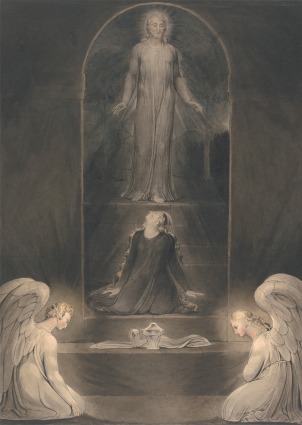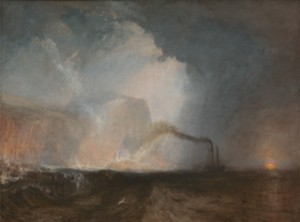
William Blake, ‘Mary Magdalen at the Sepulchre’ (c.1805). Watercolor with pen and ink on paper. 17 1/4 x 12 1/4 inches (43.8 x 31.1 cm). Yale Center for British Art, Paul Mellon Collection.
http://collections.britishart.yale.edu/vufind/Record/1670856
February’s ‘Image of the Month’ comes from Naomi Billingsley, PhD Candidate in Religions and Theology, University of Manchester, and recipient of a Bibliographical Society Studentship to assist with attendance at the third RIN symposium, ‘Literary Galleries’.
This is one of approximately eighty watercolour illustrations to the Bible produced by William Blake for his loyal patron Thomas Butts (a civil servant) between 1800 and about 1805 (several designs were added after this date but the majority were completed in this five-year period).[1] It is not clear how these designs originally functioned as illustrations: they may have extra-illustrated a large Bible or they might have been kept in their own portfolio or volume as a Bible in pictures.[2]
The design is from c.1805 and depicts Mary Magdalene at the tomb (or sepulchre) of Jesus; it is probably an illustration to John 20, because in the Gospels of Matthew, Mark and Luke, there are others with Mary when she goes to the tomb, and it is John that mentions Mary seeing ‘two angels in white sitting, the one at the head, and the other at the feet, where the body of Jesus had lain’, which Blake has included in the design (v. 12). However, Blake has compressed several moments in the narrative together in a single frame: in John’s account Mary stays ‘without’ the tomb and stoops to look inside (v. 11); she then turns around and sees Jesus but mistakes him for a gardener (v. 14). Although Blake has placed Mary on the threshold of the tomb, she is at the bottom of a flight of steps leading down to it, and so she is not stooping; Jesus stands at the top of the steps above her.
Blake has probably chosen this arrangement for compositional reasons: the design’s symmetry is characteristic of Blake’s ‘gothic’ style in this period. Indeed, this watercolour is one of six similarly symmetrical and near-monochrome designs of the death and resurrection of Christ which seem to form a sub-group within the series of biblical watercolours (The Crucifixion and the following designs – not including #499 or #503 – viewable via the Blake Archive).
Blake’s use of composition may also make a theological point. Jesus and Mary are directly aligned in the central vertical portion of the design; their arm gestures are almost identical and there is eye contact between them (see the Blake Archive’s image enlargement). This may be an expression of Blake’s idea that every person is an embodiment of Jesus – as articulated, for example, in his statement to Henry Crabb Robinson that Jesus ‘Is the only God… And so am I and so are you’[3] and his aphorism ‘The Eternal Body of Man is The Imagination. that is God himself | ישע Jesus | The Divine Body | we are his Members’.[4] So we might read Mary Magdalene here as a member of Jesus’ Divine Body, making the design not only ‘mere’ illustration but also a vehicle for Blake’s own ideas.
Any readers in the New Haven (Connecticut, USA) area will be able to see this work in the exhibition ‘The Critique of Reason: Romantic Art, 1760-1860’ between 6 March and 26 July at the Yale University Art Gallery this year.
[1] Cf. Martin Butlin, The Paintings and Drawings of William Blake (New Haven: Yale University Press, 1981): nos. 433-526.
[2] David Bindman, Blake as an Artist (Oxford: Phaidon, 1977): 144.
[3] William Blake to Henry Crabb Robinson, December 1825, in G. E. Bentley, Jr. Blake Records (New Haven: Yale University Press, 2nd Ed. 2004): 421.
[4] William Blake, ‘The Laocoön’, in David V. Erdman (ed.), The Complete Poetry and Prose of William Blake (New York: Doubleday, 1988): 273 and available via the Blake Archive.

